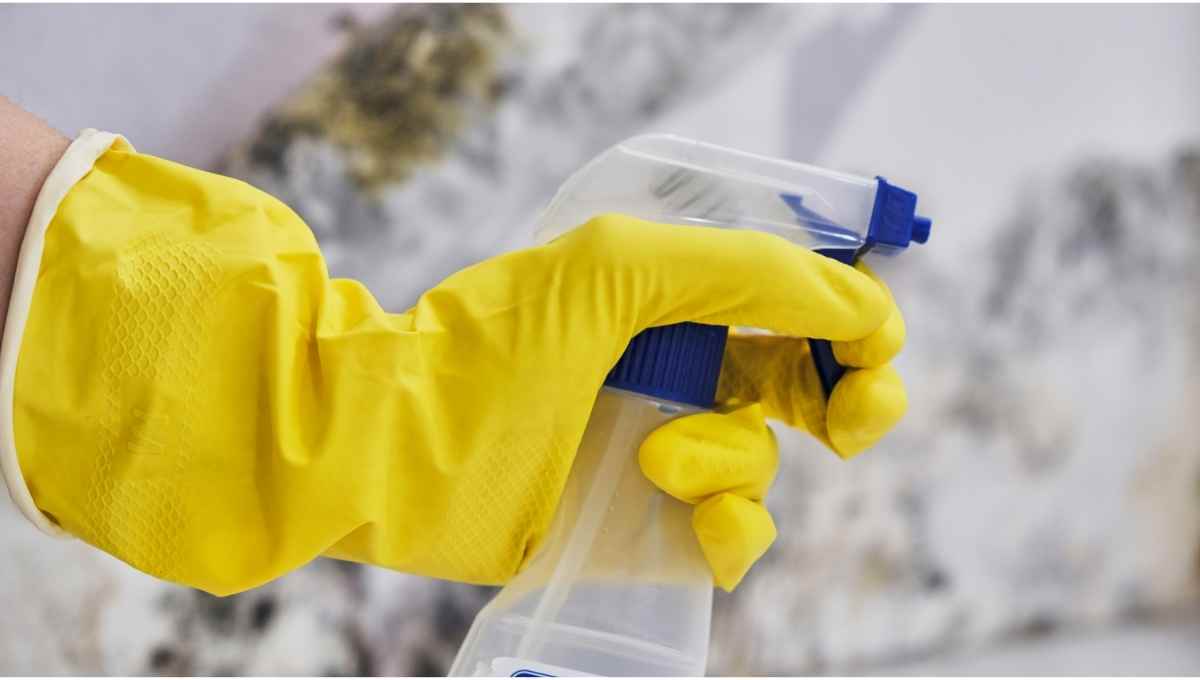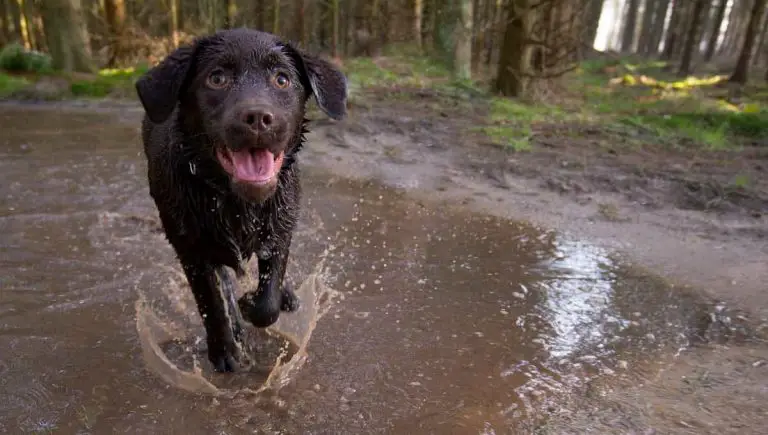Why Killing Mold With Bleach is Probably a Bad Idea

Regardless of the climate you live in, mold will always develop if the conditions are right (damp and dark areas). Before you start dousing your home surfaces with bleach though, you need to understand why killing mold with bleach is probably a bad idea.
On average, a bottle of bleach is 97% water and only 3% sodium hypochlorite (bleach). You shouldn’t use bleach to kill mold because bleach itself evaporates very quickly. This leaves the area very damp, providing leftover mold roots with water to grow back even worse than before.
In this blog post, we’re going to show you when you should and shouldn’t use bleach to kill mold, as well as better alternatives that are safer to use.
This post contains affiliate links from Amazon and other stores. This means Yard Blogger may earn a commission if you make a purchase using any of our links. Please refer to our full affiliate disclosure policy for full details.
Here’s a Quick Pro Tip!
A much better, safer, and more efficient product to use that gets rid of mold easily is the RMR-86 Pro Instant Mold Stain & Mildew Stain Remover. It’s industrial strength and gets the job done right.
Can You Kill Mold With Bleach?
Before you take out your bleach and start cleaning your home to get rid of mold, know that this chemical is only effective against certain types of material.
Mold and mold spores are everywhere and it only takes wetness and low light to get them to grow and spread throughout your home. You can tell if your home is starting to be infested with mold if you see fuzzy growths in colors of brown, black, yellow, or green, on surfaces. And the musty odor gives it away, too.
You may want to take out the bottle of bleach you have stored away, and while yes, that could work against molds, you have to keep in mind that it may still depend on what kind of surface you’re dealing with.
Bleach is an excellent cleaner for non-porous surfaces but they can’t and shouldn’t be used on drywall or wood. This method is one of the bleach mold myths that needs to be debunked. In fact, the Environmental Protection Agency advises against the use of this chemical during mold cleanup.
What Happens When You Put Bleach on Black Mold
Although it’s a powerful cleaning, there are instances why you shouldn’t use bleach on mold. This is because bleach can only clean on the surface but does not have any penetrating action.
What happens when you use bleach on black mold is that you will only deal with what’s on the surface. The mold and its roots continue to grow underneath and pretty soon, they’ll just grow back. But that’s not all – new mold will grow too.
Experts believe that by using bleach, which is usually diluted with water when used as a cleaning agent, can support new mold growth. For example, you used the bleach solution on a drywall. This will result in a wet wall, and once the bleach evaporates, the wetness remains. This will again make the spot conducive for mold growth.
Does Bleach Actually Kill Mold?
Without a doubt, bleach does kill mold but it depends on where you’re using it. Below are some of the materials that are susceptible to mold growth, but can bleach work on them?
Does Bleach Kill Mold on Plastic?
Mold can grow on plastic if the conditions are right. Store away an old plastic baby chair and you’ll find later on that some mold can grow. Plastic food containers that have left for too long inside your fridge can also develop mold.
So can bleach kill mold on plastic? The answer is yes, and since it’s a non-porous material, bleach can be effective. The right way to clean mold on plastic is to use a diluted bleach solution and let the plastic sit for about 10 minutes before rinsing with water.
Does Bleach Kill Mold on Concrete?
The basement is probably one of the most common areas in your home to find mold. And you’ll be having plenty of them on your concrete walls and floors. The trickiest part is the complete removal of mold from concrete.
Concrete is porous by nature so that means bleach cannot penetrate enough to totally kill the mold. If you want to get rid of the mold there and then, a strong solution of bleach may work. But remember, using a strong solution comes with risks, like skin irritation and inhalation of fumes.
It’s also worth noting that bleach may not harm the concrete but it does affect the paint or sealant on the concrete. So, if you wish to use bleach on concrete, make sure to consider how it affects whatever type of sealant is present.
Prevention is still the best method of making sure your basement won’t encourage mold growth. If there are leaks, fix them immediately. On the other hand, if the problem is already there and it requires a total mold cleanup, the best thing to do is to call a professional.
Does Bleach Kill Mold in the Shower?
The shower is also one of the places in your home where mold can proliferate. The constant moisture is ideal for their growth and development. The good thing is that bleach can be used in this area, assuming you have tiled surfaces.
As mentioned, bleach is excellent against mold growing on non-porous surfaces like tiles. You can also use bleach to clean your tub and glass surfaces.
Does Bleach Kill Mold on Wood?
Just like with other porous surfaces, bleach won’t work well in wood. This means the use of bleach to clean out your drywall or wooden furniture will be pointless, since mold can only come back.
Will Clorox Get Rid of Mold?

Clorox is a popular brand of household bleach used in various applications, including mold removal. The company also developed a bleach product specifically formulated to tackle mold and mildew, which is the Tilex Plus Mold and Mildew Remover.
The difference between a regular Clorox bleach and Clorox Plus Tilex is that there is no need for you to scrub the affected area. The cleaner only has to be sprayed and allowed to sit for about five to 10 minutes.
While it has a powerful cleaning action, it is marketed for use in tubs, shower doors, countertops, tiles, sinks, and shower curtains.
While Clorox is a popular household name, I personally find that RMR-86 Pro Instant Mold Stain & Mildew Stain Remover is by far the better product and most superior when it comes to cleaning and killing mold on the spot. It’s also contractor grade, which means it’s typically used for cleaning really bad mold situations.
Do Clorox Wipes Kill Mold?

Conveniently, Clorox also has made cleaning wipes that you can just take out whenever there are small spots to clean up. However, Clorox explicitly stated that their disinfecting wipes do not contain bleach and are only meant for bacteria and viruses, and not fungi or mold.
Why Is Bleach Bad for Mold
Bleach is not really all that bad for mold – you just have to use it on the right type of surface. However, the disadvantage lies in the fact that bleach is a strong chemical that can be dangerous when inhaled and can cause skin irritation. In general, you have to be familiar with some of the health concerns with using bleach on mold.
Health Concerns When Using Bleach
There are many negative health effects of using bleach as a cleaning agent, whether you’re cleaning up mold or disinfecting. Below is an outline of these health concerns:
- Bleach is extremely toxic when swallowed – so it’s best to keep it out of reach of children and pets.
- Bleach also has toxic fumes that can linger on and exposure to these fumes can cause respiratory illnesses.
- In some individuals, a stinging sensation in the eyes and nose, lightheadedness and coughing are some of the symptoms associated with bleach exposure.
- Household bleach, which is already diluted with water, may not be that corrosive, but with prolonged exposure, it can cause irritation. People with preexisting respiratory conditions like asthma will be more sensitive to their fumes.
- Bleach can damage the skin upon immediate contact, so rinse well when this happens. More importantly, it’s better to use protective gear when handling bleach.
- Another concern is when bleach is mixed with ammonia and other cleaning agents, releasing toxic fumes in your home. Be careful when using bleach with other cleaners.
What To Use Then?
If it’s unnecessary to use bleach, there are still several products available in the market that can effectively clean surfaces. Vinegar also works wonders and doesn’t have the harmful fumes to begin with.
We have discussed in detail how you can use vinegar against mold in this post. In addition, there are household cleaners that don’t contain bleach that are just as effective.
Conclusion
Bleach has been widely suggested as an effective cleaning agent to deal with mold and mildew in your home. It is true that bleach does have a powerful action against mold but keep in mind that killing mold with bleach only works on non-porous materials.
Porous surfaces like drywall and wood are best cleaned with other cleaning agents, like vinegar. Bleach cannot penetrate deep surfaces and so won’t be unable to kill mold from the roots. As a result, it will only encourage mold to grow bigger and create more problems.
You can benefit more by using vinegar, but only when it’s in a small affected area. On the other hand, if you have a big mold problem at home, the best way to deal with it is to contact a professional.






